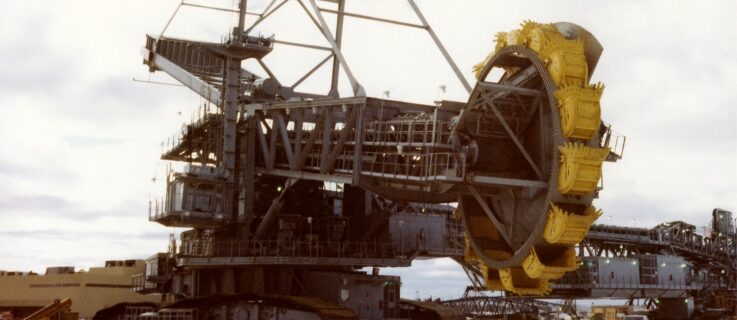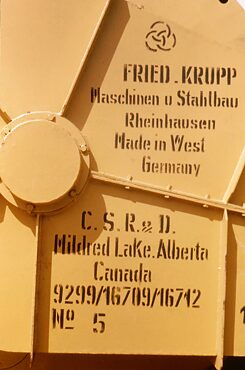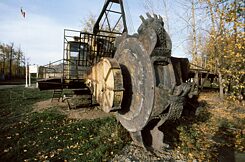German Traces in Alberta
German bucket-wheel excavators in Fort McMurray

The first commercial petroleum mining at the Athabascan oil sands near Fort McMurray in northern Alberta began at the end of September 1967. German machinery was used right from the beginning.
In order to cut through the thick, partly frozen ground and extract the Canadian tundra’s bitumen-soaked soil, the "Great Canadian Oil Sands Company" (now called "Suncor Energy") had imported bucket-wheel excavators from Germany. These heavy, 1700-tonne machines have been tried and tested in open-pit coal mining around the world, but in the harsh tundra they quickly lost their strength. The teeth of the buckets were blunted by the hard ground and had to be replaced every 48 hours. In addition, the bucket excavators were severely affected by the harrowing conditions of the Canadian winters. The extreme temperatures, which get down to -40° Celsius, can make the steel very brittle. There are reports from witnesses of a steel jib-arm simply breaking down the middle because of the cold back in the 1980s.
 The inscription of the bucket-wheel excavators gives information about its origin
| © Roy Hawkins Collection, Fort McMurray Heritage Society
Before new, more cost-effective mining procedures were introduced in the 1990s, bucket excavators were a part of everyday life in mining regions. They became a symbol of the production of synthetic crude oil from the Alberta oil sands. Specially created for the brown coal mining industry in Germany, these electrically powered excavators were 120m wide and could get as high as 30m tall. They were among the most powerful machines in the world with an output of 2700 metric horsepower. Each machine had 14 buckets that dug the bitumen out of the earth and hoisted it onto a huge mobile conveyor belt. Put into operation in 1967, these machines were shipped to Canada in pieces and brought to Fort McMurray on a special train. Transporting the pieces and reassembling them on location required 40 carriages and 50 000 hours of work. When used at night, the sparks generated from the buckets striking the ice-age rock of the tundra could be seen from far away.
The inscription of the bucket-wheel excavators gives information about its origin
| © Roy Hawkins Collection, Fort McMurray Heritage Society
Before new, more cost-effective mining procedures were introduced in the 1990s, bucket excavators were a part of everyday life in mining regions. They became a symbol of the production of synthetic crude oil from the Alberta oil sands. Specially created for the brown coal mining industry in Germany, these electrically powered excavators were 120m wide and could get as high as 30m tall. They were among the most powerful machines in the world with an output of 2700 metric horsepower. Each machine had 14 buckets that dug the bitumen out of the earth and hoisted it onto a huge mobile conveyor belt. Put into operation in 1967, these machines were shipped to Canada in pieces and brought to Fort McMurray on a special train. Transporting the pieces and reassembling them on location required 40 carriages and 50 000 hours of work. When used at night, the sparks generated from the buckets striking the ice-age rock of the tundra could be seen from far away.
 A smaller Krupp bucket-wheel excavator from 1984 in the Heritage Park
| © Fort McMurray Heritage Society
Today, two decommissioned German bucket-wheel excavators are exhibited in and around Fort McMurray. Visitors can see a relatively small example of an excavator made by the company "Krupp" preserved in the Heritage Village. Weighing in at 52 tonnes with the ability to excavate 75 tonnes of earth an hour, it’s considered a baby bucket-wheel excavator. It was used for the first exploratory mining operations at the Athabascan oil sands as early as 1958. Another bucket-wheel excavator is on display at the outdoor exhibition “Giants of Mining” put on by the company "Syncrude Canada Ltd.", located on Highway 63 about 40 km outside the city. This one was constructed by the companies "Friedrich Krupp AG and Orenstein & Koppel" and assembled by the "Bechtel Corporation" between 1977 and 1978. It can excavate more than 6000 tonnes of bitumen per hour.
A smaller Krupp bucket-wheel excavator from 1984 in the Heritage Park
| © Fort McMurray Heritage Society
Today, two decommissioned German bucket-wheel excavators are exhibited in and around Fort McMurray. Visitors can see a relatively small example of an excavator made by the company "Krupp" preserved in the Heritage Village. Weighing in at 52 tonnes with the ability to excavate 75 tonnes of earth an hour, it’s considered a baby bucket-wheel excavator. It was used for the first exploratory mining operations at the Athabascan oil sands as early as 1958. Another bucket-wheel excavator is on display at the outdoor exhibition “Giants of Mining” put on by the company "Syncrude Canada Ltd.", located on Highway 63 about 40 km outside the city. This one was constructed by the companies "Friedrich Krupp AG and Orenstein & Koppel" and assembled by the "Bechtel Corporation" between 1977 and 1978. It can excavate more than 6000 tonnes of bitumen per hour.
Fort McMurray Heritage Village
1 Tolen Dr
Fort McMurray, AB T9H 1G7
Comments
Comment